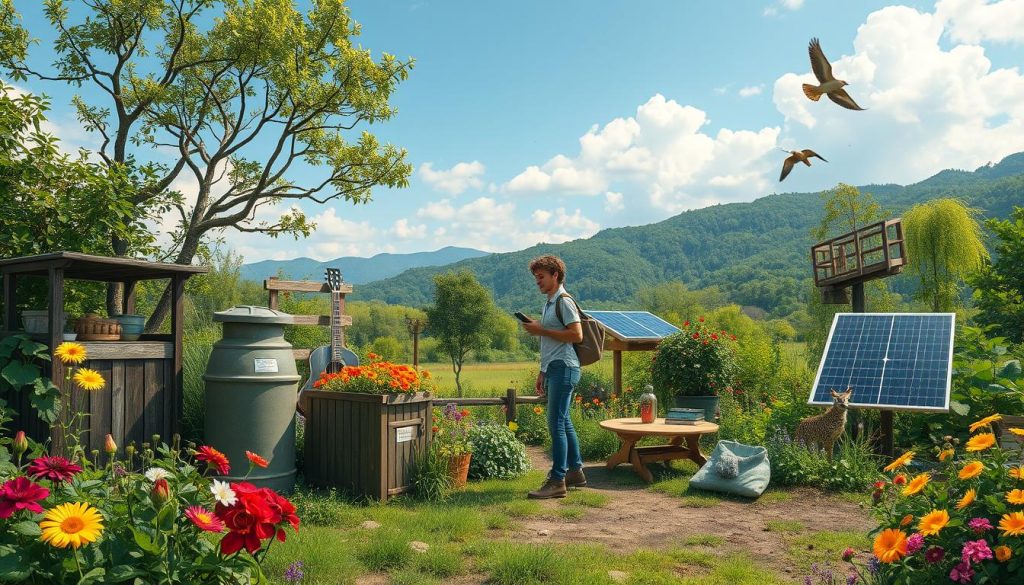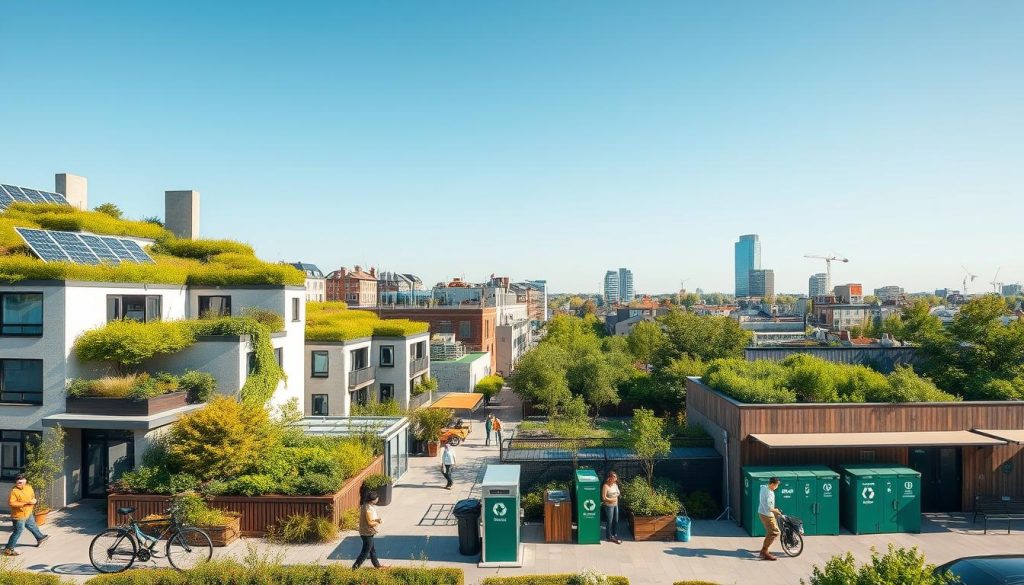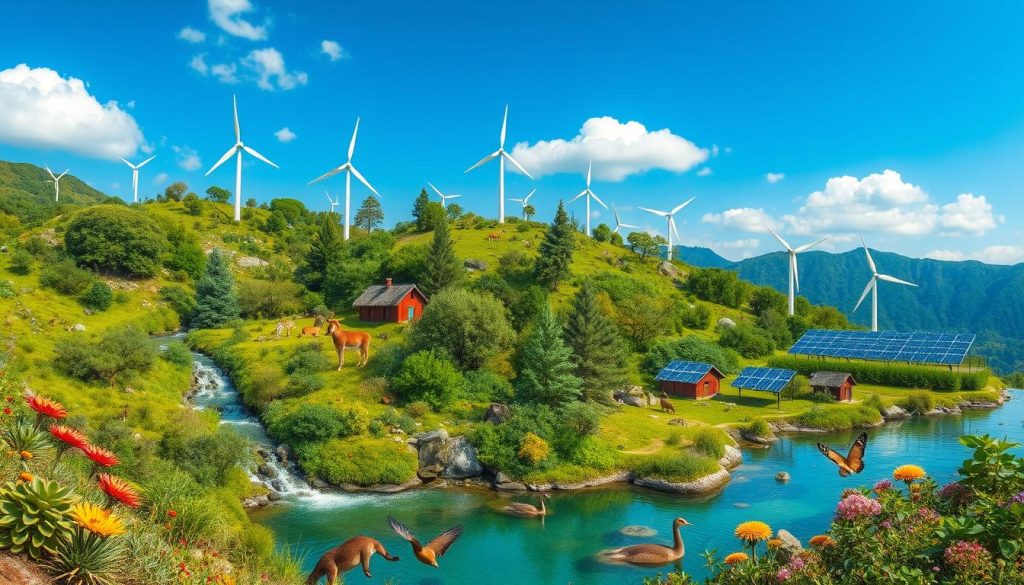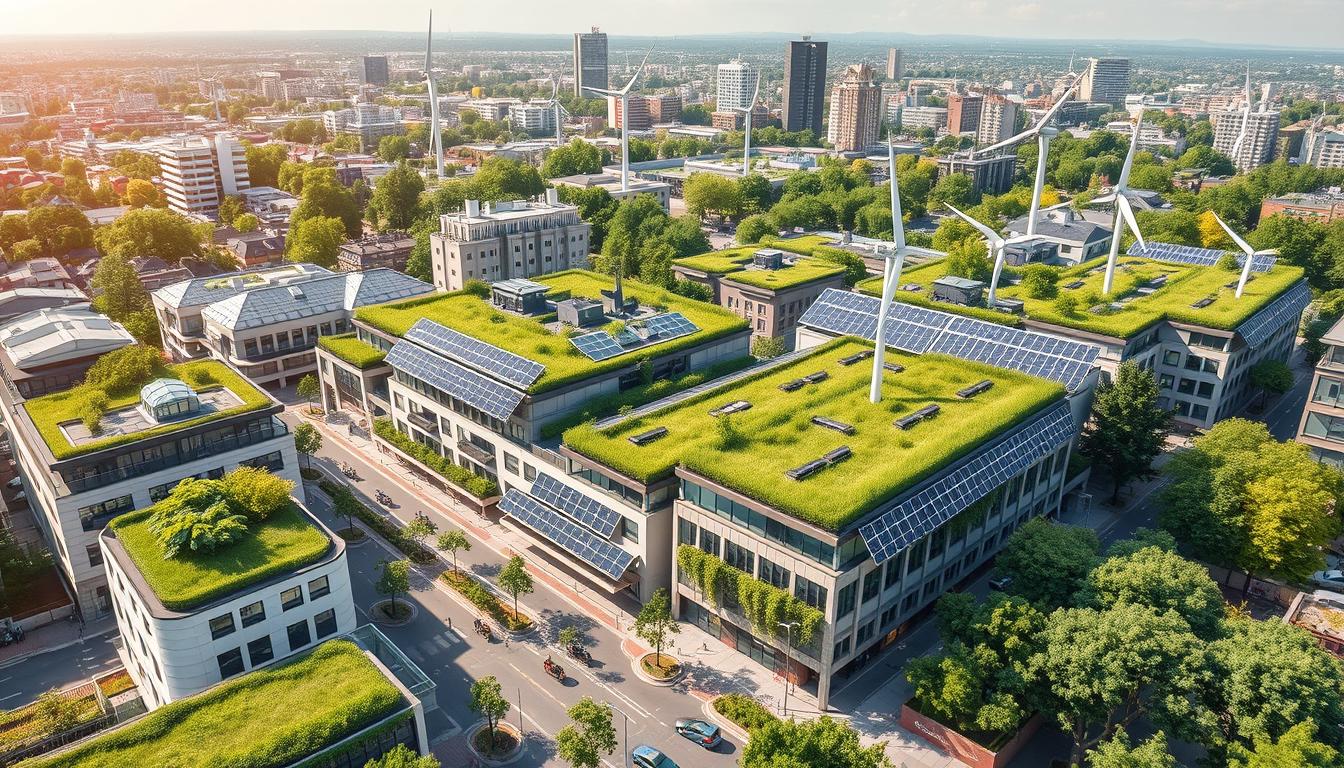The world is facing big challenges like climate change and running out of resources. The circular economy is a light of hope for a better future. It’s different from the old way of taking, making, and throwing things away. Instead, it keeps using resources by recycling, reusing, and finding new uses for them.
By focusing on using less waste and being more efficient with resources, we can move towards a cycle of growth and success. This new way of thinking is not just about being eco-friendly. It’s about changing how we live with our planet. The circular economy is all about sustainable development and green innovation that helps everyone, not just the planet.
Choosing a sustainable future with the circular economy is not just necessary—it’s exciting. Let’s explore how circular practices can make our world a better place.
Understanding the Circular Economy Concept
The circular economy is a new way of thinking about how we use things. It focuses on making things last longer and using resources better. This approach aims to reduce waste and make the most of what we have.
What is the Circular Economy?
The circular economy is a system where things are used over and over again. It’s different from the old way of using, then throwing things away. This new way encourages us to reuse, repair, and recycle more.
Key Principles of Circularity
Being part of the circular economy means:
- Designing out waste and pollution
- Keeping products and materials in use
- Regenerating natural systems
These ideas help us make things last longer and use resources better. They help businesses and people work towards a greener future.
Benefits of Embracing Circularity
There are many good things about the circular economy:
- Environmental: It helps reduce waste and pollution
- Economic: It creates jobs and saves money
- Social: It makes communities healthier
Knowing these benefits encourages us all to move towards a more sustainable world. It’s about working together for a better economy and planet.
| Aspect | Traditional Economy | Circular Economy |
|---|---|---|
| Waste Management | Dispose | Reuse/Recycle |
| Resource Use | Finite | Regenerative |
| Environmental Impact | High | Low |
My Journey to Embrace Circular Practices

Starting my journey to adopt circular practices was a big step. I wanted to live more sustainably and help the planet. It meant making small changes in my daily life, like managing waste better and using resources wisely.
Initial Steps I Took
I began by making my home more eco-friendly. I stopped using single-use plastics and started using reusable items instead. I also started composting and buying second-hand things. These small actions helped me live more sustainably.
Challenges I Faced
Changing my habits was not easy. Finding eco-friendly alternatives that were easy to use and affordable was hard. Sometimes, I felt frustrated by the lack of good waste management in my area. But these problems made me even more determined.
Transformative Outcomes
The changes I made had a big impact. My efforts led to less waste at home and made me more mindful of sustainability. Talking to friends and others showed me how our small actions can add up. It proved that we can all make a difference together.
Innovative Circular Economy Examples

Looking at the forefront of the circular economy, we see many examples of green innovation and renewable energy. These stories show how circular business models can change the game.
Successful Brands Leading the Way
Many brands are leading the way in the circular economy. Companies like Patagonia and IKEA are at the forefront. They focus on recycling, repairing, and reusing products.
Patagonia’s Worn Wear program lets customers trade in used clothes. These clothes are then fixed and sold again. IKEA is making furniture more sustainable with designs that are easy to recycle.
Real-Life Case Studies
Businesses are finding creative ways to apply circular principles. For example, Interface, a carpet maker, recycles old carpets into new ones. This has cut down on waste and the need for raw materials.
Tesla is another big name in the circular economy. They promote renewable energy with electric cars and recycle batteries. This ensures their products have a sustainable life cycle.
Inspiring Community Initiatives
At the local level, we see the power of circularity in action. Repair Cafés, where volunteers fix broken items, encourage community involvement. Urban farming collectives also play a role by turning organic waste into compost.
These efforts show how circular business models can bring people together. They highlight the importance of working together for a sustainable future.
| Brand | Initiative | Impact |
|---|---|---|
| Patagonia | Worn Wear | Promotes recycling and extends product life |
| IKEA | Modular Designs | Facilitates easy disassembly and recycling |
| Interface | Carpet Recycling | Reduces waste and raw material use |
| Tesla | Battery Repurposing | Ensures a sustainable product lifecycle |
How Circular Economy Impacts the Environment

Using circular economy practices helps a lot in reducing our harm to the environment. It changes how we use and throw away materials. This makes our world more sustainable and strong.
Reducing Waste and Pollution
The circular economy focuses on managing waste well. This greatly reduces waste and pollution. Companies that follow circular ways use materials better, making less trash.
This method also cuts down on pollutants in the air, water, and soil. It makes our environment cleaner and healthier for everyone.
Resource Conservation Benefits
Another big plus of the circular economy is saving resources. It makes the most out of products and materials, needing less raw materials. This saves natural resources and protects habitats and ecosystems.
It also means future generations will have the resources they need.
Climate Change Mitigation
The circular economy plays a huge role in fighting climate change. It reduces emissions by using resources efficiently and making less waste. This lowers the carbon footprint of making and using things.
This supports global efforts to fight climate change. It shows the importance of sustainable practices for our planet’s health.
In summary, moving towards a circular economy has big effects on the environment. It changes how we manage waste, save resources, and fight climate change. Adopting circular practices is key to a sustainable future.
Circular Economy’s Role in Business
Businesses can gain a lot by using circular economy principles. They see better efficiency, less waste, and a boost in their brand image. Let’s look at how companies are changing and the good results they get.
Shifting Business Models
More companies are moving to circular business models. These models focus on using products and materials again and again. This makes businesses more sustainable and helps keep resources available for longer.
Companies like IKEA and Patagonia are at the forefront. They show others how to be more eco-friendly.
Cost Savings through Circular Practices
Using circular business models can save a lot of money. By cutting down on waste and using resources better, companies spend less on materials and waste disposal. For example, Unilever has made big savings by changing its supply chain.
| Company | Implemented Circular Practices | Cost Savings |
|---|---|---|
| Unilever | Supply Chain Optimization | Significant |
| Interface | Carpet Recycling | Moderate |
| Nike | Product Remanufacturing | High |
Enhancing Brand Reputation
Going green is good for the planet and for a company’s image. Today’s shoppers care about the environmental impact of what they buy. Brands that focus on sustainability, like Apple and Adidas, win customer loyalty and repeat business.
In short, circular business models are a win-win. They help companies save money and improve their image. Businesses that go green are set to do well in a market that values sustainability.
My Tips for Adopting Circular Practices at Home
Starting a sustainable lifestyle is rewarding and impactful. Here are my tips for making your home more circular.
Simple Changes to Implement
It’s easy to go green. Begin with small steps that add up to big changes.
- Replace single-use items with reusable ones, like bags and bottles.
- Compost kitchen waste to cut down on landfill and improve your garden.
- Choose second-hand or upcycled items for furniture and decor.
Resources for Sustainable Living
Finding the right tools makes living sustainably easier. Here are some helpful resources:
- Eco-Friendly Apps: Apps like Good On You help you pick sustainable fashion. OLIO lets you share food with neighbors.
- Local Initiatives: Join groups like Repair Cafes to learn repair skills.
- Online Guides: Treehugger has lots of articles and guides for a greener life.
Encouraging Others to Join Me
Working together is key to lasting change. Here’s how to get others involved:
- Share your sustainable journey on social media or forums.
- Plan neighborhood swap events for items like clothes and appliances.
- Host workshops on eco-friendly topics, like DIY cleaning or composting.
The Future of Circular Economy
The circular economy is on the verge of a big change. New trends will make current practices better and reach more people worldwide. Changes in policies and new business ideas are building a greener economy.
Trends to Watch
Several important trends are emerging in the circular economy. We’re seeing more circular practices in making things, sharing and renting items, and holding companies responsible for their products. These changes are key to growing the circular economy and keeping it sustainable.
The Role of Technology
Technology is vital for the circular economy’s success. New tech, like better recycling and tracking products, is making a big difference. These tools help cut down waste and make the most of resources.
How I See My Role in This Transition
I plan to play a big part in this change. I’ll keep learning and sharing what I know about sustainability. I’ll also support new ideas that fit with circular economy goals. My goal is to help spread the word and encourage everyone to work towards a greener future.
